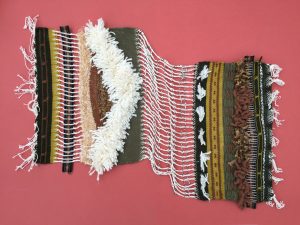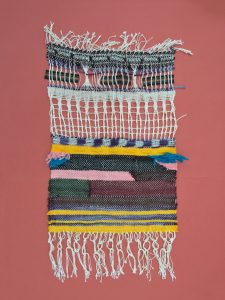Ashley Chan Weaving

Intention
While making my sample weaving, I found that I very much enjoyed weaving for the sake of experimentation and as a way to familiarize myself with different techniques. I wanted to keep building up these skills but making the final weaving more cohesive as a whole. So I went to Creative Reuse with the intention of finding yarns that could make a strong color scheme but also found that I was extremely attracted to yarns with different textures. From there, I knew that I wanted my weaving to be a sensory experience, inspired by the yarns I was reacting to. I chose the earthy color scheme because in the moment, those colors attracted to me.
Process
For the most part, I worked in sections, weaving using a technique that in the moment I felt like doing. I loved working with the leno from my sample weaving so I knew that I wanted it to be in my final weaving too but for the most part, I worked spontaneously and in the moment. The building of sections was reactionary from the previous sections. For example, the colors as well as the technique I would choose was heavily influenced by the section that came before it. I wanted to be conscious about what I was making in relation to what was already weaved because I was very concerned with balance of color and contrast. For example, if I had just completed a section with light green and yellow danish medallions, I knew somewhere soon, I would want to use a technique that was more tactile with a lighter color scheme to balance out the darkness of the green and flatness of the design.
Learning
I very quickly learned that I much prefer weaving with abstract concepts and designs. In my critique, there was a strong reaction to how my piece was hung horizontally, versus vertically, and I was surprised by how orientation and the background color influenced the effect of my piece. Even during documentation, I experimented more with the shape of my weaving and found an even more sculptural form for it to take.
It’s interesting because I started playing with orientation when I finished my weaving, unwound it from the loom and was immediately displeased by how much space I allowed the leno to take up in relation to the rest. At the time, I desperately wished I could redo it and make that section much shorter but in the end, I believe that space allowed me to experiment with different forms that changed the overall rhythm and movement of my weaving. I’m still not 100% satisfied with this final orientation but that might be more indicative of a building-off project.
While I enjoy the different styles that my peers explored in their final weavings, graphic imagery isn’t something I would willingly explore but I would still want to learn how to create traditional weaving patterns. Something I would want to explore in the future is transforming these weavings into functional products like wearables or functional textiles.
